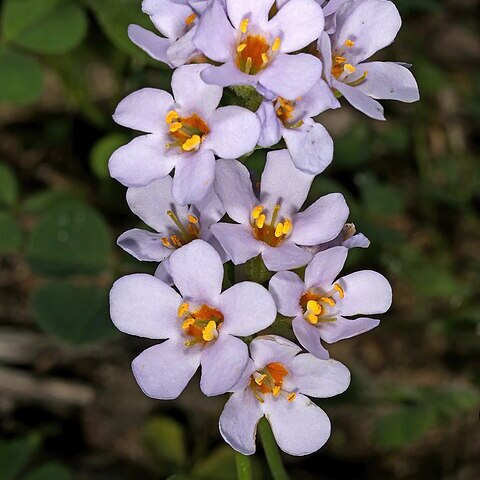Perennial herb capable of flowering when young, taproot woody eventually developing into a knotty rootstock c. 15 mm in diam. at crown, stem soon branching from base and above, branches decumbent or sprawling, erect in early stages of growth, up to c. 600 mm long, pubescent with acute hairs on lower parts up to 0.5-1 mm long, soon mixed with glandular hairs, ultimate inflorescence axes and pedicels with glandular hairs only, glistening glands also present, leafy throughout. Leaves opposite, largest c. 15-30 x 10-17 mm, ovate or elliptic, either broad-based and sessile or tapering to a short petiolar part, apex ± acute, margins serrate, both surfaces pubescent, hairs up to 0.25-0.4 mm long, glistening glands as well. Flowers solitary in the leaf axils, often from very low down on the stem, then branching towards the tips into very leafy panicles, the flowers then crowded (seen only in well-grown specimens). Bracts, that is leaves, at base of inflorescence c. 9-20 x 4-16 mm. Pedicels (lowermost) c. 5-20 mm long. Calyx obscurely bilabiate, tube 1 mm long, lobes 3.5-4.8 x 0.8-1 mm, glandular-pubescent, the coarser hairs up to 0.5-1.2 mm long, glistening glands as well. Corolla tube 5-8 x 4-5 mm in throat, broadly funnel-shaped, limb almost regular, 8-14 mm across, posticous lobes 2.5-4 x 2.1-3.8 mm, anticous lobe 3-5 x 3-4.2 mm, all oblong-orbicular, pale mauve, tube yellow or orange, glandular-puberulous outside, glistening glands as well, 5 bands of clavate hairs inside. Stamens 4, all exserted, anthers 1-1.5 mm long, posticous filaments 1.5-2 mm long, anticous ones 2.5-4 mm. Stigma 1-2.2 mm long, exserted. Style 3.2-6 mm long. Ovary 1-1.5 x 0.8-1.2 mm, glistening glands all over, sometimes tiny glandular hairs as well. Capsules c. 4-5.5 x 2.5-4 mm, glistening glands persistent. Seeds 0.5-1 x 0.3-0.6 mm, amber-coloured. Can possibly be found in flower in any month.
More
Perennial herb, but can appear annual, branches up to 600 mm long, with acute and glandular hairs at base and top respectively, mixed in between. Leaves opposite, elliptic or ovate, ± acute, serrate, pubescent. Flowers single in leaf axils, appearing crowded near top in leafy panicles in well-grown, much-branched plants. Corolla: tube 5-8 mm long, wide, yellow or orange; lobes light mauve. Flowering time perhaps all year.

